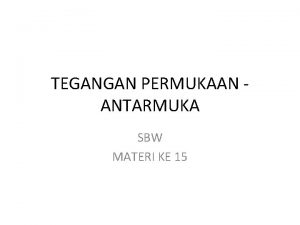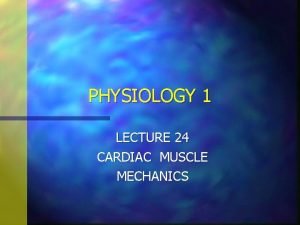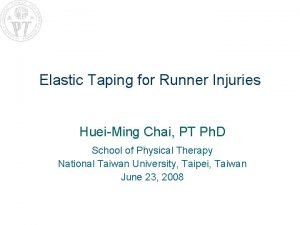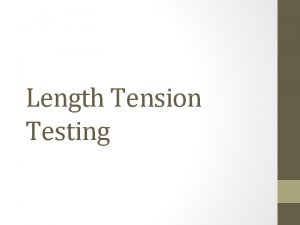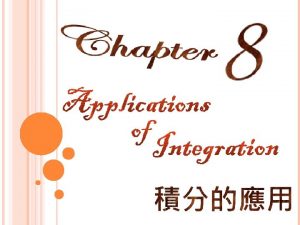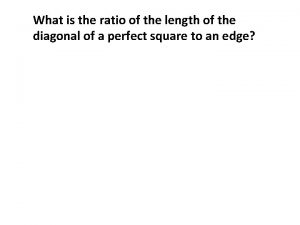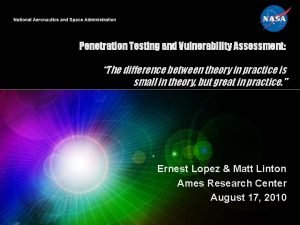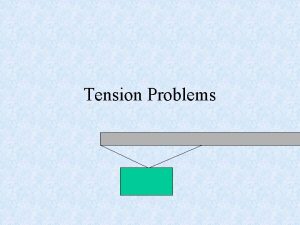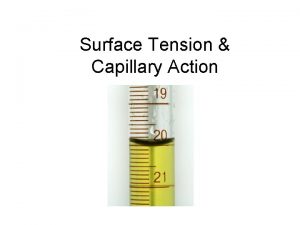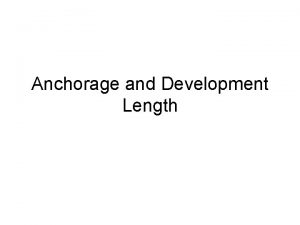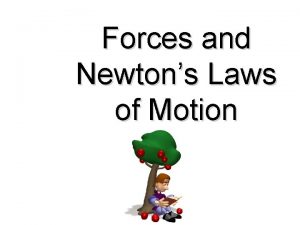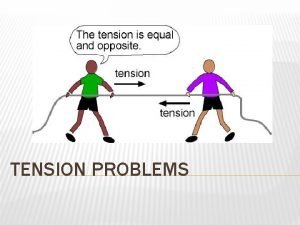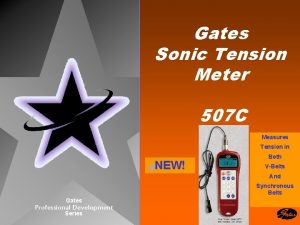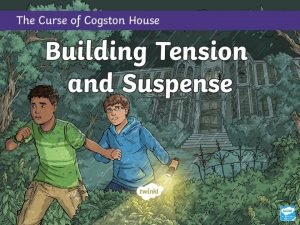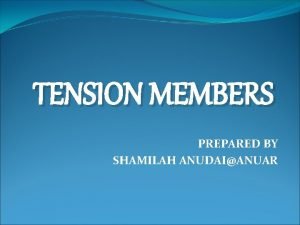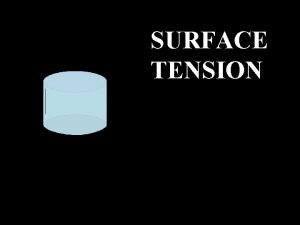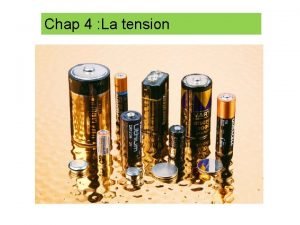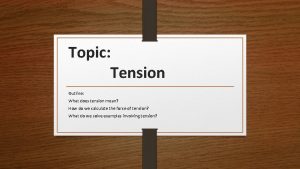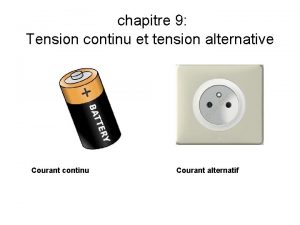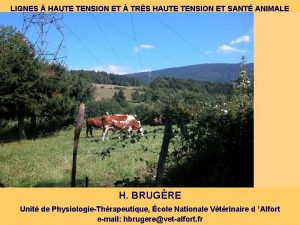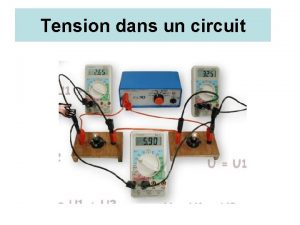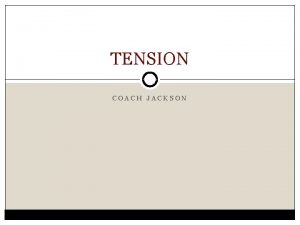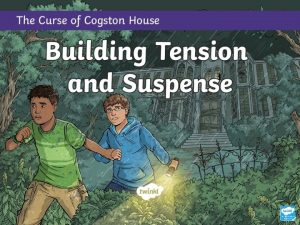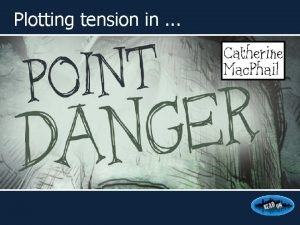Length Tension Testing Length Tension Testing Assessment of























- Slides: 23

Length Tension Testing

Length Tension Testing • Assessment of length tension in skeletal muscle from the use of clinical reasoning, interpretation and subjective and objective assessment findings • Assessment Findings Include: referral pain, neuromusculoskeletal interaction or neuromeningeal identification (nerve restrictions or nervous system responsiveness/sensitivity), positional observation, ROM, palpation, and overall activation and flexibility of the muscle • Range of motion and end feel of muscle is assessed from therapists hand moving and stabilizing the structure - sense the tension in the muscle • End feel = Joint restriction • Normal muscle = will feel soft will contract voluntary with EMG activity • Tense muscle = will feel stiff, like a well done steak contributes to muscle spasm and pain, EMG not under voluntary control because of decreased contractile ability • Symptoms during stretch noted

Soleus Muscle Origin (Proximal) Attachment: Posterior proximal half, on the surface of the tibia, along soleal line proximal 1/3 posterior fibula Insertion: Posterior Calcaneus Action: Plantar Flexion Nerve: Tibial Nerve root (S 1, S 2)

Soleus Length Tension Test Patient Position: - Supine lying position with leg hanging over edge of bed Action: - One hand supports knee in a slight flexed position, while other hand forearm supports plantar aspect (bottom) of the foot - Patients ankle is dorsiflexed, while range of motion and end feel of muscle is assessed (hand moving and hand stabilizing sense the tension in the muscle) - Symptoms during stretch noted

PICTURE (Soleus mm length , 2010)

Piriformis Muscle Origin (Proximal) Attachment: Anterior surface of lateral sacrum Insertion: Greater trochanter of femur, along upper medial surface Action: Laterally rotates the thigh at hip joint, If hip is flexed it will abduct the thigh Nerve: Sacral Plexus (S 1, S 2)

Piriformis Length Tension Test Patient: - Supine lying with hip flexed at 100° and knee flexed at 90° Action: - Therapist stabilizes innominate and supports distal aspect of the tibia and fibula with hand forearm - Hip is adducted and laterally rotated - Range of motion and end feel of hip is assessed (hand moving and hand stabilizing sense the tension in the muscle) - Symptoms during stretch noted

PICTURE (Cram, 2013)

Hamstring (3 Muscles) Origin (Proximal) Attachment: Biceps Femoris: Ischial tuberosity Semimembranosus: Ischial tuberosity Semitendinosus: Ischial tuberosity Insertion: Biceps Femoris: Head of fibula and lateral condyle of tibia Semimembranosus: Posterior medial condyle of tibia Semitendinosus: Proximal tibia, medial to tibial tuberosity Action: Extends thigh at the hip Nerve: Tibial portion of sciatic nerve (L 5, S 1, S 2)

Hamstring Length Tension Test Patient: - Lying supine Action: - Therapist palpates anterior iliac spine and iliac crest - Distal aspect of tibia and fibula are supported by a hand - Leg is taken into hip flexion with the knee extended - When right innominate starts to posteriorly rotate, flexibility of the hamstring is exhausted - Range of motion and end feel of hamstring is assessed (hand moving and hand stabilizing sense the tension in the muscle) - Symptoms during stretch noted

PICTURE (Hamstring rehab protocol, 2013)

Quadriceps (4 Muscles) Origin (Proximal) Attachment: Rectus Femoris: Anterior Iliac spine and illium above the accetabulum Vastus Lateralis: Greater trochanter Vastus Medialis: Intertrochantric line Vastus Intermedius: Anterior and lateral shaft of femur Insertion: Quadriceps tendon, to base of patella into tibial tuberosity from the patellar ligament Action: Extends leg at the knee joint Nerve: Femoral Nerve (L 2, L 4)

Quadriceps Length Tension Test Patient: - Lying on stomach with legs extended Action: - Therapist stabilizes the sacroiliac joint - Distal aspect of tibia and fibula is supported by therapists hand - Therapist flexes knee joint to target the quadriceps - Range of motion and end feel of quadriceps is assessed (hand moving and hand stabilizing sense the tension in the muscle) - Symptoms during stretch noted

PICTURE (Schafer, 1985)

Trapezius Muscle Origin (Proximal) Attachment: Medial superior nuchal line and external protuberance of the occipital bone, ligamentum nuchae and spinous processes of C 7 T 12 Insertion: Clavicle (lateral), acromion, and spine of scapula Action: Upper Fibers – Elevate and upwardly rotate scapula (extend neck) Middle Fibers – Adduct scapula (retract) Lower Fibers – Depress scapula Nerve: C 3, C 4 and accessory cranial N.

Trapezius Length Tension Test (Upper Fibers) Patient: - Sitting position on a chair Action: - Patient actively flexes craniovertebral joint (articulation between cranium and vertebral column) - Therapist stabilizes lateral 1/3 clavicle and acromion with one hand stabalizes the top of the head with the other hand - Therapist passively flexes and rotates the head down towards the patients shoulder - Range of motion and end feel of trapezius is assessed (hand moving and hand stabilizing sense the tension in the muscle) - Symptoms during stretch noted

PICTURE (Boost physio, 2012)

ARTICLE - Upper Trapezius Muscle Activity During the Brachial Plexus Tension Test in Asymptomatic Subjects • The brachial plexus tension test (BPTT) is used to test the dynamics of the neural tissues of the upper quadrant – using contralateral cervical lateral flexion • The upper trapezius muscle and the nerves of the brachial plexus share common anatomical locations and are jointly affected by the BPTT movements. • This study investigated the relationship between the BPTT and the upper trapezius muscle activity - tested the range of neural tissue extensibility in asymptomatic subjects. • Thought that upper trapezius shortening is an adaptation to protect less extensible neural tissue from the action of stretching (upper limb movements) • 20 healthy male subjects tested (age 18 -30) • BBTT = shoulder depression, glenohumeral abduction, and external rotation, forearm supination, wrist and finger extension and elbow extension • Contralateral cervical lateral flexion (CCFL) was added as a final BBTT component • Base Line Pre- Test Maximum voluntary contraction (MVC) was recorded (EMG) while subject was lying supine during shoulder abduction and external rotation • After MVC , BPTT was performed, paused at shoulder depression when pain felt and at limits of elbow extension and contralateral cervical lateral flexion (CCFL) - - Pain rating was recorded (scale 0 -10) • Results revealed that those with lesser neural extensibility exhibited greater upper trapezius muscle activity during the BPTT • No difference between groups in the levels of pain perceived.

Palmaris Longus Origin (Proximal) Attachment: Medial epicondyle of humerus Insertion: Flexor retinaculum and palmer aponeurosis Action: Flexes hand at the wrist joint, tenses palmer aponeurosis Nerve: Median N. (C 7, C 8)

Palmaris Longus Length Tension Test Patient: - Lying supine Action: - Therapist stabilizes patients distal humerus and extends the patients elbow and wrist with all of the patients fingers and thumb extended - Range of motion and end feel of palmaris longus is assessed (hand moving and hand stabilizing sense the tension in the muscle) - Symptoms during stretch noted

PICTURE (Morphopedics, 2009)

ARTICLE - Reliability of Upper Limb Tension Test 1 in Normal Subjects and Patients With Carpal Tunnel Syndrome • Four neural tension tests in upper extremity (ULTT) • ULTT 1 – evaluates upper quadrant nerve system tension, and the corresponding structures tension , particularly median N. • ULTT 1 (through movement and tension) is thought to help with the diagnosis of carpal tunnel syndrome • Upper limb tension test consisted of elbow extension , shoulder depression, shoulder abduction and external rotation, forearm supination , and wrist and elbow extension • Believed that the median N. is stretched during ULTT 1 • Subjects: two groups (healthy and patients) • 23 healthy subjects (age 18 -25) • 12 CTS patients (age 25 -50) • Results determined that ULTT 1 is reliable and can be used to diagnose and help manage carpal tunnel syndrome

Work Cited Boost physio. (2012). Retrieved from http: //www. boostphysio. com/blog/tag/hendon-physio/ Cram. (2013). Retrieved from http: //www. cram. com/flashcards/clskspecial-tests-2460528 Get body smart. (2014). Retrieved from http: //www. getbodysmart. com/ap/muscularsystem/wris thanddigits/palmarislongus/tutorial. html Hamstring rehab protocol using lengthened state eccentrics. (2013). Retrieved from http: //activeptblog. com/2013/10/14/hamstring-rehab protocol-using-lengthened-state-eccentrics/ Morphopedics. (2009). Retrieved from http: //morphopedics. wikidot. com/elbow-joint Sanzo , P. , & Mac. Hutchon, M. (2007). Length tension testing of the lower quadrant. Thunder Bay: Active Potential Rehabilitation Services. Sanzo , P. , & Mac. Hutchon, M. (2007). Length tension testing of the upper quadrant. Thunder Bay: Active Potential Rehabilitation Services. Schafer, R. (1985). The motion palpation institute & acapress. Retrieved from http: //www. chiro. org/ ACAPress/The_Pelvis. html Soleus mm length. (2010). Retrieved from https: //www. google. ca/search? q=soleus length test&rlz=1 C 1 KMZB_en. CA 564&espv=210&es_sm=93&source=lnms&tbm=isch &sa=X&ei=Pd. U 0 U 7 i. LKojmr. QHcto. GYCQ&ved=0 CAYQ_AUo. AQ&biw=1366&bih=667
 Spin coat
Spin coat Transference
Transference Rumus tegangan permukaan air
Rumus tegangan permukaan air Inotrophy
Inotrophy Length tension curve
Length tension curve Length tension test
Length tension test Area of surface of revolution
Area of surface of revolution What is the ratio of the length of to the length of ?
What is the ratio of the length of to the length of ? Redesigned sat 1
Redesigned sat 1 Process oriented learning competencies
Process oriented learning competencies Static assessment vs dynamic assessment
Static assessment vs dynamic assessment Portfolio assessment matches assessment to teaching
Portfolio assessment matches assessment to teaching Difference between pen testing and vulnerability assessment
Difference between pen testing and vulnerability assessment Domain testing in software testing methodologies
Domain testing in software testing methodologies Logic based testing in software testing
Logic based testing in software testing Du path testing
Du path testing Positive vs negative testing
Positive vs negative testing Cs3250
Cs3250 Anuj magazine
Anuj magazine Functional testing vs unit testing
Functional testing vs unit testing What is testing
What is testing Control structure testing in software testing
Control structure testing in software testing Decision table testing in software testing
Decision table testing in software testing Decision table testing examples
Decision table testing examples


